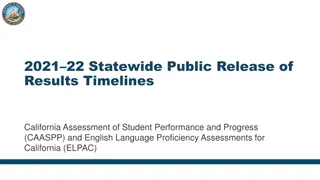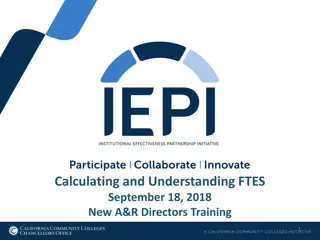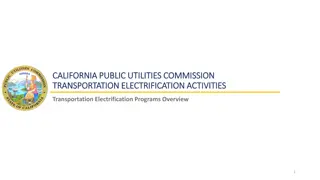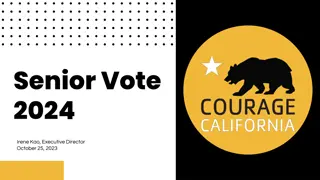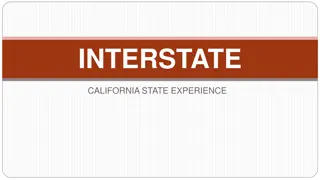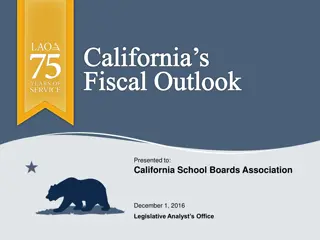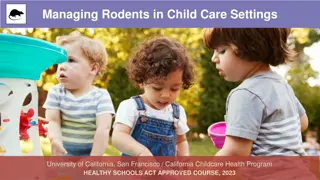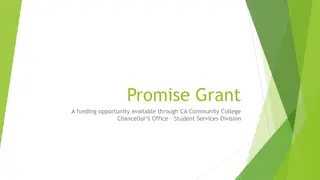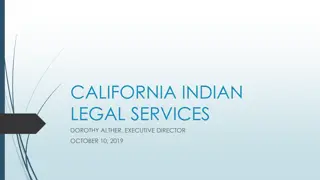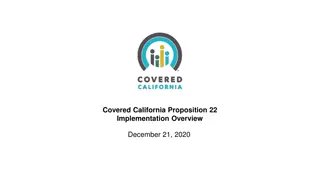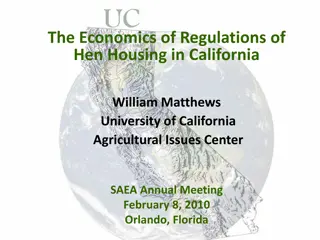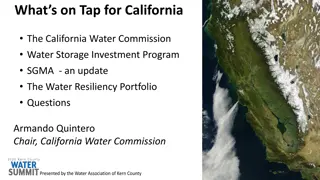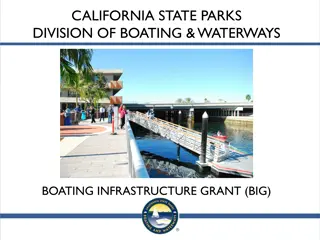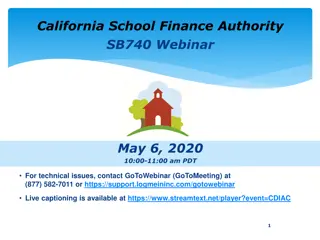California's No Place Like Home Program Overview
The No Place Like Home Program (NPLH) in California addresses the high percentage of homelessness in the state by providing funding for permanent supportive housing for individuals in need of mental health services. The program aims to combat homelessness by prioritizing vulnerable populations and offering flexible and individualized supportive services. Key features include county eligibility, low barrier tenant selection practices, and a focus on mental health services. The program goals encompass improving the quality of life for homeless individuals with mental illness through Housing First initiatives and innovative program services. An advisory committee assists in program implementation and progress monitoring.
Download Presentation

Please find below an Image/Link to download the presentation.
The content on the website is provided AS IS for your information and personal use only. It may not be sold, licensed, or shared on other websites without obtaining consent from the author. Download presentation by click this link. If you encounter any issues during the download, it is possible that the publisher has removed the file from their server.
E N D
Presentation Transcript
No Place Like Home Program (NPLH) AB 1618 AB 1628 California Department of Housing and Community Development March 2017
California has the Highest Percentage of People Experiencing Homelessness in the Nation Source: 2015 AHAR: Part 1 - PIT Estimates of Homelessness in the U.S 2
California Lags Behind the Rest of the Nation in Combating Homelessness California 21% 12% 4% 5.5% Veteran Homelessness Chronic Homelessness Family Overall Homelessness Homelessness 11% 36% 22% 19% United States 3
NPLH Background Signed into law on July 1, 2016. Authorization of $2 billion in bond proceeds to invest in the development of permanent supportive housing for persons who are in need of mental health services and are experiencing homelessness, chronic homelessness, or who are at risk of chronic homelessness. The bonds are repaid through Mental Health Services Act revenues. 4
Key Features Counties will be eligible applicants (either solely or with a housing development sponsor). Funding for permanent supportive housing must utilize low barrier tenant selection practices that prioritize vulnerable populations and offer flexible, voluntary, and individualized supportive services. Counties must commit to provide mental health services and help coordinate access to other community-based supportive services. 5
NPLH Program Goals Permanent Supportive Housing to improve quality of life for people who are homeless and experience mental illness Housing First Flexible, Voluntary, and Individualized Services Innovation in Program Services and Delivery Continuity of Care Housing Projects in Proximity to Community Services Framing Paper released with comment period ending in January. 6
NPLH Advisory Committee Comprised of 15 members, including State agencies, and Governor and legislative appointees. The Advisory Committee will assist and advise HCD in the implementation of the program, review and make recommendations on program guidelines, and review the progress in distributing awards. Director of Housing and Community Development, Chair Director of Health Care Services or Designee Department of Health Care Services Additional Representative Secretary of Veterans Affairs or Designee Director of Social Services or Designee State Treasurer or Designee Chair of the Mental Health Services Oversight and Accountability Commission or Designee Chief Administrative Officer or Member of a County Board of Supervisors, Small County Chief Administrative Officer or Member of a County Board of Supervisors, Large County Director of a County Behavioral Health Department Administrative Officer of a City Resident of Supportive Housing Representative of a Local or Regional Continuum of Care Organization Mental Health Organization Representative of an Affordable Housing Organization 7
Program Components and Timeline
NPLH Program Eligible Uses: ACQUISITION CAPITALIZED OPERATING RESERVE DESIGN PRESERVATION COSTS CONSTRUCTION REHABILITATION 9
Some Differences with CalHFA MHSA Program Construction financing not available Counties with over 5% of share of state homeless population can take funds and administer on own (LA, SF, SD, and Santa Clara) Trying to take lessons learned Capitalized Operating Subsidy Reserve 20-Year Commitment to Provide Supportive Services to NPLH Tenants 10
Program Components and Timeline How much: Authorization of $2 billion $1.8 billion Competitive/Alternative Program $200 million Non-Competitive / Over-the-Counter Who can apply: Counties (alone or in partnership with Developers) Target Populations: Chronically Homeless At-risk of Chronic Homelessness Homeless All persons must have a serious mental illness 11
Program Components Overview and Timeline Competitive Program: Up to $1.8 billion Allocated to regions of counties based on population-size Formula-based allocations Large Counties - Population Size >750,000 Los Angeles County NPLH County Groupings Small Counties - Population Size <200,000 - 8% is set aside within the competitive program Medium Counties -Population Size 200,000-750,000 12
Program Components Overview and Timeline Non-Competitive / Over-the-Counter Funds: Up to $200 million available to all counties Allocation formula is based on HUD Point in Time Count Data Minimum allocation of $500,000 Funds available continuously for first eighteen months Technical Assistance: $6.2 million Grants to counties based on population size Money available over the counter beginning in March through June 2017 13
Definitions Three Target Populations Chronically Homeless (HUD Definition at 24 CFR 578.3) Homeless (HUD Definition at 24 CFR 578.3) At-Risk of Chronic Homelessness (NPLH Definition) All target populations must be adults living with a diagnosed Serious Mental Disorder or children or adolescents with a Serious Emotional Disturbance as defined under MHSA (WIC Section 5600.3). 14
Competitive Program: Threshold Requirements Eligible Applicant: o County as sole applicant if it is a development sponsor, or jointly with a separate entity as a development sponsor. Development Team Capacity: o Two affordable rental housing projects funded in the last 10 years, one must include 1 PSH unit for Homeless, Chronically Homeless, or those At-Risk of chronic homelessness. o 3 years experience of Lead Service Provider and Property Manager in serving NPLH Target Population. o Collaboration among entities is imperative. 15
Competitive Program: Threshold Requirements Project must be integrated o Projects of 20+ units, no more than 49% of the units will be restricted as NPLH units. Projects of 20 or fewer units can restrict more than 49%, but Article 34 of state constitution applies. o NPLH units integrated with other project units o Encourage social interaction Community building activities Architectural design No special restrictions on guests 16
Competitive Program: Threshold Requirements Project Financial Feasibility o Conform with HCD Uniform Multifamily Regulations o Tenant incomes cannot exceed 30% AMI o Rents restricted from 15%-30% AMI o Tenant pays no more than 30% of income in units with Capitalized Operating Subsidy Reserves or rent subsidy. 17
Competitive Program: Threshold Requirements Eligible Housing Types o Minimum 5 units o Can be single developments, scattered-site, or shared housing o Common ownership, financing, and property management o Each tenant signs a lease o Permanent foundation, meet State and local codes, minimum sq. footage requirements. 18
Competitive Program: Threshold Requirements 20-yr Supportive Services o County commits to provide mental health services & coordinate provision/referral to other services, including but not limited to substance use treatment services. o County-Approved Supportive Services Plan o Required Minimum services offered: o On-site case management o Mental health services o Substance use services o Physical health care services o Benefits counseling and advocacy o Life skills o On-site peer support and advocacy o Transportation plan o Recreational and social activities o Housing retention services o Linkages to community resources o Recreational and social activities 19
Competitive Program: Threshold Requirements Low-Barrier Tenant Selection Practices o Housing First Practices o Eligibility not limited to clients of County Mental Health Department, as long as the tenant has a qualifying diagnosis under MHSA. Adults Serious Mental Illness Children/Adolescents Serious Emotional Disturbance 20
Competitive Program: Threshold Requirements County Homelessness Plan o Local Continuum of Care Plan o MHSA Plan addressing homelessness o Other County Plan o Subject to public input, publically approved, easily accessible/available. o May use NPLH Technical Assistance funds to develop 21
Alternative Program: Los Angeles, San Diego, San Francisco, and Santa Clara For Alternative Program counties to administer their own funds they must: Have a minimum of 5% of the State s homeless population as measured through HUD Point In Time Count data. Demonstrate the capacity to directly administer loan funds for permanent supportive housing serving the Target Population. Have the ability to prioritize those with mental health needs who fit the Target Population criteria consistent with program requirements. Counties participating in the Alternative Program shall not be eligible for funds available through the Competitive Program funding pool. 22
Topics with Significant Feedback Alternative County process and administration Coordinated Entry System At Risk of Chronic Homelessness Definition Integration requirements Outcome measures Services/service plan requirement Threshold requirements 23
Anticipated Timeline Initial Research, Stakeholder Outreach, Advisory Committee Recruitment Fall 2016 Release of Framework Paper and Start of Public Comment Period Advisory Committee Meetings Begin Winter 2016 March 2017 Release of Draft Guidelines for Comment April 2017 Completion of Guidelines/Beginning of Validation Summer 2017 Release of Notice of Funding Availability Winter 2018* *Subject to completion of a court validation process 24
More information on new HCD website at www.hcd.ca.gov California Department of Housing and Community Development 2020 West El Camino Avenue Sacramento, CA. 95833








